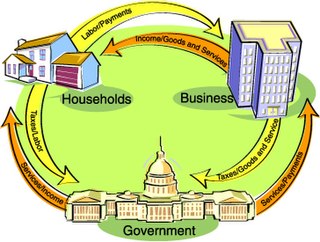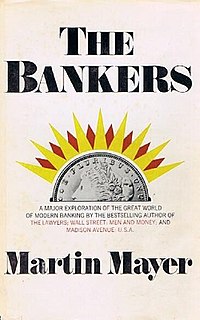Related Research Articles

The Federal Reserve System is the central banking system of the United States of America. It was created on December 23, 1913, with the enactment of the Federal Reserve Act, after a series of financial panics led to the desire for central control of the monetary system in order to alleviate financial crises. Over the years, events such as the Great Depression in the 1930s and the Great Recession during the 2000s have led to the expansion of the roles and responsibilities of the Federal Reserve System.

Monetary policy concerns the actions of a central bank or other regulatory authorities that determine the size and rate of growth of the money supply. For example, in the United States, the Federal Reserve is in charge of monetary policy, and implements it primarily by performing operations that influence short-term interest rates.
The Federal Deposit Insurance Corporation (FDIC) is one of two agencies that provide deposit insurance to depositors in American depository institutions, the other being the National Credit Union Administration, which regulates and insures credit unions. The FDIC is a United States government corporation providing deposit insurance to depositors in American commercial banks and savings banks. The FDIC was created by the 1933 Banking Act, enacted during the Great Depression to restore trust in the American banking system. More than one-third of banks failed in the years before the FDIC's creation, and bank runs were common. The insurance limit was initially US$2,500 per ownership category, and this was increased several times over the years. Since the passage of the Dodd–Frank Wall Street Reform and Consumer Protection Act in 2011, the FDIC insures deposits in member banks up to US$250,000 per ownership category. FDIC insurance is backed by the full faith and credit of the government of the United States of America, since its inception in 1933 no depositor has ever lost a penny of FDIC-insured funds.

In macroeconomics, the money supply refers to the total volume of money held by the public at a particular point in time in an economy. There are several ways to define "money", but standard measures usually include currency in circulation and demand deposits. The central bank of each country may use a definition of what constitutes money for its purposes.

The Reserve Bank of India (RBI) is India's central bank and regulatory body under the jurisdiction of Ministry of Finance, Government of India. It is responsible for the issue and supply of the Indian rupee and the regulation of the Indian banking system. It also manages the country's main payment systems and works to promote its economic development.

Fractional-reserve banking, the most common form of banking practiced by commercial banks worldwide, involves banks accepting deposits from customers and making loans to borrowers while holding in reserve an amount equal to only a fraction of the bank's deposit liabilities. Bank reserves are held as cash in the bank or as balances in the bank's account at a central bank. The country's central bank determines the minimum amount that banks must hold in liquid assets, called the "reserve requirement" or "reserve ratio". Banks usually hold more than this minimum amount, keeping excess reserves.
Full-reserve banking is a system of banking where banks do not lend demand deposits and instead, only lend from time deposits. It differs from fractional-reserve banking, in which banks may lend funds on deposit, while fully reserved banks would be required to keep the full amount of each depositor's funds in cash, ready for immediate withdrawal on demand.
A transaction account, also called a checking account, chequing account, current account, demand deposit account, or share draft account at credit unions, is a deposit account held at a bank or other financial institution. It is available to the account owner "on demand" and is available for frequent and immediate access by the account owner or to others as the account owner may direct. Access may be in a variety of ways, such as cash withdrawals, use of debit cards, cheques (checks) and electronic transfer. In economic terms, the funds held in a transaction account are regarded as liquid funds. In accounting terms, they are considered as cash.

A bank run occurs when many clients withdraw their money from a bank, because they believe the bank may cease to function in the near future. In other words, it is when, in a fractional-reserve banking system, numerous customers withdraw cash from deposit accounts with a financial institution at the same time because they believe that the financial institution is, or might become, insolvent; they keep the cash or transfer it into other assets, such as government bonds, precious metals or gemstones. When they transfer funds to another institution, it may be characterized as a capital flight. As a bank run progresses, it generates its own momentum: as more people withdraw cash, the likelihood of default increases, triggering further withdrawals. This can destabilize the bank to the point where it runs out of cash and thus faces sudden bankruptcy. To combat a bank run, a bank may limit how much cash each customer may withdraw, suspend withdrawals altogether, or promptly acquire more cash from other banks or from the central bank, besides other measures.
A savings and loan association (S&L), or thrift institution, is a financial institution that specializes in accepting savings deposits and making mortgage and other loans. The terms "S&L" or "thrift" are mainly used in the United States; similar institutions in the United Kingdom, Ireland and some Commonwealth countries include building societies and trustee savings banks. They are often mutually held, meaning that the depositors and borrowers are members with voting rights, and have the ability to direct the financial and managerial goals of the organization like the members of a credit union or the policyholders of a mutual insurance company. While it is possible for an S&L to be a joint-stock company, and even publicly traded, in such instances it is no longer truly a mutual association, and depositors and borrowers no longer have membership rights and managerial control. By law, thrifts can have no more than 20 percent of their lending in commercial loans—their focus on mortgage and consumer loans makes them particularly vulnerable to housing downturns such as the deep one the U.S. experienced in 2007.
The reserve requirement is a central bank regulation that sets the minimum amount of reserves that must be held by a commercial bank. The minimum reserve is generally determined by the central bank to be no less than a specified percentage of the amount of deposit liabilities the commercial bank owes to its customers. The commercial bank's reserves normally consist of cash owned by the bank and stored physically in the bank vault, plus the amount of the commercial bank's balance in that bank's account with the central bank.
Demand deposits or non-confidential money are funds held in demand accounts in commercial banks. These account balances are usually considered money and form the greater part of the narrowly defined money supply of a country. Simply put, these are deposits in the bank that can be withdrawn on demand, without any prior notice.
Regulation Q is a Federal Reserve regulation which sets out capital requirements for banks in the United States. The current version of Regulation Q was enacted in 2013.

The Depository Institutions Deregulation and Monetary Control Act of 1980 is a United States federal financial statute passed in 1980 and signed by President Jimmy Carter on March 31. It gave the Federal Reserve greater control over non-member banks.

The Bankers is the 1974 book by the economist-writer Martin Mayer that describes the industry just at the cusp of deregulation. At the time, banks had just been released from the interest rate ceilings of Regulation Q imposed by the Federal Reserve. Also, NOW accounts allowed checkable deposits to earn interest. This period, the mid to late 1970s saw an explosion of financial markets innovation with money market mutual fund accounts, call and put options traded first over the counter then on listed exchanges and finally bank deregulation as failed banks were taken over by out of state banks.
Bank regulation in the United States is highly fragmented compared with other G10 countries, where most countries have only one bank regulator. In the U.S., banking is regulated at both the federal and state level. Depending on the type of charter a banking organization has and on its organizational structure, it may be subject to numerous federal and state banking regulations. Apart from the bank regulatory agencies the U.S. maintains separate securities, commodities, and insurance regulatory agencies at the federal and state level, unlike Japan and the United Kingdom. Bank examiners are generally employed to supervise banks and to ensure compliance with regulations.

A bank is a financial institution that accepts deposits from the public and creates a demand deposit while simultaneously making loans. Lending activities can be directly performed by the bank or indirectly through capital markets.

In financial transactions, a warrant is a written order by one person that instructs or authorises another person to pay a specified recipient a specific amount of money or supply goods at a specific date. A warrant may or may not be negotiable and may be a bearer instrument that authorises payment to the warrant holder on demand or after a specific date. Governments and businesses may pay wages and other accounts by issuing warrants instead of cheques.
Reserve Requirements for Depository Institutions is a Federal Reserve regulation governing the reserves that banks and credit unions keep to satisfy depositor withdrawals. Although the regulation still requires banks to report the aggregate balances of their deposit accounts to the Federal Reserve, most of its provisions are inactive as a result of policy changes during the COVID-19 pandemic.
A deposit account is a bank account maintained by a financial institution in which a customer can deposit and withdraw money. Deposit accounts can be savings accounts, current accounts or any of several other types of accounts explained below.
References
- 1 2 Mishkin, Frederic S. (2007). The Economics of Money, Banking, and Financial Markets (Alternate ed.). Boston: Addison Wesley. p. 220. ISBN 978-0-321-42177-7.
- 1 2 "Federal Register Volume 76, Number 72 (Thursday, April 14, 2011)". Federal Register. 76 (72). April 14, 2011. See section on Federal Reserve System
- 1 2 3 Mitchell, Douglas W., Interest-Bearing Checking Accounts and Macro Policy, Ph.D. dissertation, Princeton University, 1978.
- ↑ "BUSINESS PEOPLE; Haselton Brothers' Role In Banking Innovations". The New York Times . 4 January 1983. Retrieved 2012-05-17.
- ↑ Gilbert, Alton (February 1986). "Requiem for Regulation Q: What It Did and Why It Passed Away" (PDF). Federal Reserve Bank of St. Louis: 31.Cite journal requires
|journal=(help)